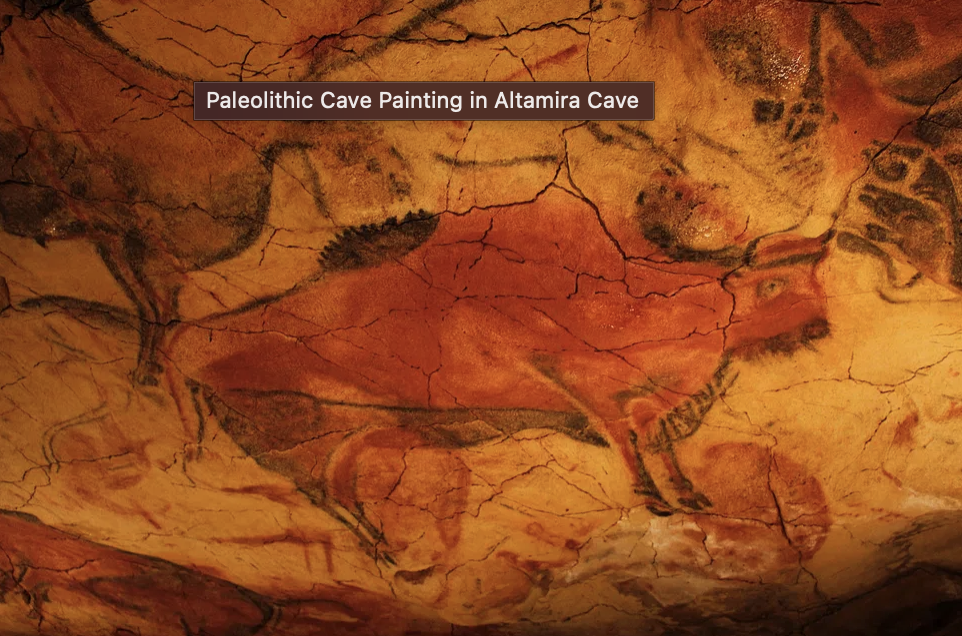The Cave of Altamira is one of the biggest archaeological discoveries in history. The cave was discovered by Modesto Cubillas in 1868. It is located in the Spanish province of Cantabria, near the town of Santillana del Mar. The first excavation works of the site began in 1879. In 1985, the cave was declared a UNESCO World Heritage Site, and the cave has since been closed to the public for conservation reasons.
The cave was formed due to collapses due to karstic phenomena of Mount Vispieres. It is about 1,000 meters long, consisting of a series of passages and chambers. It can be divided into three sections; the entrance, the polycrome room, and the gallery. Archaeologists have discovered artifacts from Upper Solutrean (c. 18,500 years ago) and Lower Magdalenian (c. 16,590 – 14,000 years ago) periods, implying that humans inhabited the cave in these time periods. In between these two time periods, the cave was inhabited only by animals.
When Juan Vilanova y Piera and Marcelino Sanz de Sautuola, the first archaeologists to excavate the site, published their work, it was met with much skepticism. A group of French specialists were adamant in rejecting the work of Sautuola and Piera. They argued that the paintings were too well maintained and contained too much artistic quality to be from the Paleolithic era. Sautuola was even accused of paying a contemporary artist to forge the paintings. In 1902, due to other prehistoric paintings being found, the French specialists recant their statements and apologized for their mistake in opposing the work of the original archaeologists.

Archeologists have found animal bones, ash from fireplaces, and flint objects such as knives and axes. Since these artifacts were discovered in different layers of sediments, it is assumed that humans inhabited the cave for long periods of time. The cave was likely well positioned, allowing the inhabitants to take advantage of the wildlife that lived in the valleys of the surrounding mountains. Evidence of human inhabitants has only been discovered at the mouth of the cave.
The most famous aspect of the cave is the numerous cave paintings that line the walls. The paintings depict animals, abstract shapes, human hands, and a series of dots. There are 25 colored images in the cave, mostly red and black. The humans that made the paintings used a flint object to engrave the wall, charcoal to draw a black lines. Later, color was added to the drawings. Impressively, the painters took advantage of the natural contours of the cave walls, giving a three dimensional look to their art.

The Cave of Altamira has significantly shifted our views on human life in the Paleolithic period. This was the first time that Paleolithic cave art was discovered, showing that people from this era were able to make carvings and paintings onto rock formations. The cave also gives an insight into the daily life of people of this era, as well as their culture.
Citation:
Lidya Pelayo Alonso, “Atlamira”. World History Encyclopedia. December 13, 2015. https://www.worldhistory.org/Altamira/.
Alvarez, Stephen, “Altamira Cave.” Ancient Art Archive. April 3, 2022. https://www.ancientartarchive.org/altamira-cave-spain/.
Raphael Minder, “Back to the Cave of Altamira in Spain, Still Controversial”. The New York Times. July 30, 2014. https://www.nytimes.com/2014/07/31/arts/international/back-to-the-cave-of-altamira-in-spain-still-controversial.html
Additional Links:

“The cave also gives an insight into the daily life of people of this era, as well as their culture” — What do these paintings convey? What creative narratives/perspectives are present, and what dietary/cultural/artistic patterns do these paintings unveil?
These paintings convey that early humans were capable of expressing creativity in the form of art. A creative narrative that is present is that the animals are depicted in different positions, which some historians have interpreted as meaning to show the movements and interactions of the animals. These paintings unveil dietary patterns by showing the importance of hunting in the human diet, cultural patterns by showing the importance of the human-animal relationship to human culture, and artistic patterns by showing the artistic methods that early humans invented.